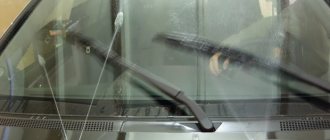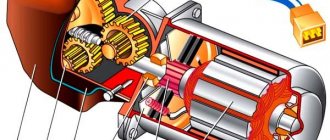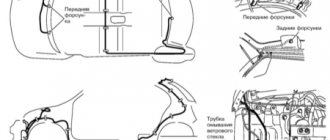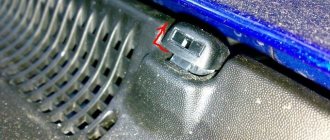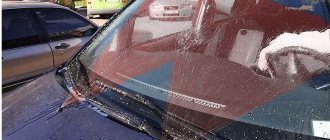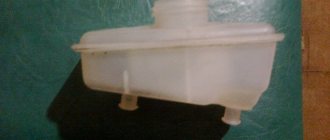The windshield washer pump provides sufficient pressure in the system to supply water to the glass. This is one of the most important components in a car, which is always necessary, and not just in bad weather. Let's figure it out with you where the windshield washer motor is installed, what its features are and how to replace and clean it.
The principle of operation of the motor
This motor is used to create the necessary pressure and supply water. Its design differs depending on the brand. This is due to the fact that sometimes water supply is required not only to the windshield, but also to the rear view glass. In general, the principle of operation is no different from that characteristic of any other water pump, it’s just that this one has small dimensions and works not only with water, but also with washer fluid, that is, in an aggressive environment. The windshield washer motor can fail, like any other component in the car, but unlike the same engine, every driver can easily repair it on his own.
Washer fuse location
In different cars, the fuse blocks and the fuses themselves are located in different orders; there is no single standard so that the block is, for example, on the right and there is a certain order of which fuse is responsible for what. Find out the location of the block and a specific fuse, for example, when replacing the cigarette lighter fuse. Therefore, we will consider for specific brands and models of cars in the photo.
On a VW Jetta 6 (Volkswagen Jetta 6), the washer fuse is located in the engine compartment, to the right of the engine.
Location of the washer fuse in the block of the VAZ 2110. The block itself is located in the passenger compartment on the driver's side. The fuse responsible for the operation of the washer is number 9 (second from the right from the top).
Location of washer fuse Wolksvagen Passat B7
Typical causes of unit failure
Over a long period of car servicing, most car service specialists identify the following “standard” motor breakdowns:
- damage to terminals;
- disconnecting the hose;
- clogged injectors;
- Washer switch malfunction.
These are the problems that occur most often. The most common and simple one is that the hose under the hood has come off. The liquid enters and simply pours into the engine compartment. In general, the problem is not critical; just adjust the hose and everything will work immediately.
As many years of practice have shown, the mechanism itself is simple and extremely reliable, so it very rarely fails. Another thing is that the contacts oxidize and may not give the desired signal. Or everything is so clogged with rust and dirt that the pump is unable to push through this plug. Situations are different, in any case, if the windshield washer motor does not work, you need to figure it out and see what’s wrong. Sometimes the reasons lie on the surface.
Details of the whole
As you can see, the window washing system is not that complicated. It consists of several simple components: a motor, a tank and injectors. Of course, there are also lines through which the washer fluid passes. The pump pumps liquid, which, under pressure, approaches the tee. Tee - washer fluid distributor. Then it is sprayed through the nozzles directly onto the center of the windshield and spread around the perimeter by the wipers.
Nothing complicated, but at the same time there are a lot of details. In the event of a malfunction, immediately check the tank and its integrity, as well as the nozzle; it may be clogged with dirt that needs to be removed. Next, check the pump - if it buzzes, then everything is in order. If not, disconnect and completely clean, also clean the terminals. Highways are also a fairly important element. They may bend or break somewhere, and the liquid will not pass through. And, of course, the injectors play their role. To save washer fluid, they spray it very sparingly. From this we can conclude that the spray holes are small in diameter. Therefore, there are often cases when they become clogged and the system stops working.
Daewoo Matiz EAR STICK › Logbook › Replacing the windshield washer reservoir without removing the bumper
4. Remove the neck of the tank. You can’t go anywhere without open-end wrenches)) The neck can be immediately removed by pulling the base.
5. Now we disconnect the front plastic cover on the bumper, which contains the turn signals. To do this, unscrew the 4 bolts on top. And then carefully unfasten it from the bumper - there are latches there. It is not necessary to remove it completely.
6. We move it back a little and under the headlight in the depths we see the last third bolt securing the tank. We unscrew it as best we can.
It is very inconvenient to unscrew it if there is no flexible cardan. Therefore, this is what I did) The tightening torque there is not great if no one climbed before you, so I just tightly taped the head to the cardan with electrical tape so that it could change the angle a little.
And it worked! At the same time, I also unscrewed the bumper mounting bolt and bent the fastening slightly so that the cardan could fit.
Source
How to replace a windshield washer motor
As noted above, the design of the motor may differ depending on the brand of car. This also applies to its location. However, if you can find the windshield washer reservoir, there shouldn't be any problems. What you will need from the tool is a regular flathead and Phillips screwdriver, as well as a set of keys.
As for the components, their price tag is low. Purchases will cost 500-1,500 rubles, depending on what you purchase. Then we proceed directly to the replacement. We find the tank and motor. We disconnect the terminals; it is advisable to check them immediately. If there is a large amount of rust, then it must be carefully removed and try to check the performance of the system.
Instructions for replacing the windshield wiper motor
Some drivers believe that it is cheaper to disassemble the windshield washer motor and replace worn parts. If a decision is made to repair the device, then the worn and broken parts in the disassembled electric motor are replaced, and the repaired device is installed in its original place.
Disassembled reservoir pump
It's easier to replace the electric motor. To do this, you will need a standard set of keys and a flathead and Phillips screwdriver.
Replacing the windshield washer motor consists of the following steps:
- First, turn off the power supply to the car by disconnecting the negative terminal from the battery.
- Next, we find the motor according to the manual and turn off the power from it by disconnecting the wires that go to it from the battery.
- Before replacing, drain the fluid from the system.
- The next step is to remove the washer reservoir motor. To do this, you can either dismantle the tank or remove the device without dismantling it.
- Then you need to disconnect all the tubes. When unscrewing the tubes, follow the way they were screwed on in order to screw them in correctly during assembly.
- We clean the seized electric motor from contaminants, repair it or buy a new one.
- We install the repaired or new pump in the reverse order.
- When the system is assembled, new fluid is poured in. After this, you can use the washer.
There is no point in delaying windshield wiper repairs, as during bad weather, a dirty windshield impairs visibility on the road, which can cause an accident. You can replace and clean the mechanism yourself, which will save time and money.
Price issue
Below are some examples of windshield washer motors.
1. Motor for Nissan Tiida (price from 1500 rub.)
2. Washer pump for Skoda Octavia (price from 1400 rub.)
3. Washer motor for BMW (price from 500 rub.)
Loading …
We continue repair work
Once you have determined where the windshield washer motor is located and disconnected it, you need to follow these steps. Drain the liquid, if there is any in the system. To do this, disconnect the hose and fitting. Next you need to push the intake out of the sealing sleeve. The easiest way to do this is with a regular flat-head screwdriver. At the same time, we try not to damage anything, since the products are quite fragile. Now we can disconnect the pump from the tank and start cleaning it. You can clean it in any convenient way, preferably with a regular eraser - it’s simple and fairly quick.
How much does a windshield washer motor cost if it breaks? If for a domestic car, then a couple of hundred rubles, if for a foreign car, it’s more expensive. Usually 1,000 or more. But it needs to be changed only if there is obvious mechanical damage or critical wear.
Do-it-yourself troubleshooting
The main reasons for the lack of washer fluid can be eliminated with your own hands.
Cleaning the injectors
Their replacement and cleaning occurs in the same way and it begins with the removal of these parts, the process is as follows:
- open the hood;
- make sure that they have plastic plugs; if they are present, they must be carefully removed;
- take a flat-head screwdriver and open their spring fasteners to remove the injectors.
Installation of new parts occurs in the reverse order.
To wash the injectors and free them from dirt, you should prepare a special cleaning solution of non-chlorinated water and vinegar, taken in equal proportions. The mixture is mixed well and then poured into the tank. After which you need to press the washer lever, even if the water does not reach the glass, it’s okay. So that the components of the solution have time to break down all the contaminants, you need to leave it in the cleaning system for 2 hours, and then press the lever again. After the dirty solution flows out of the nozzles, rinse the hoses with distilled water.
Replacing the motor
It is quite difficult to repair the motor yourself, so most often it is simply replaced.
Installation of a new device is carried out as follows:
- remove all liquid remaining in the tank from the tank;
- disconnect the contact between the battery and the pump;
- if necessary, you can dismantle the tank, but if manipulations can be carried out with a fixed device, then you don’t have to do this;
- remove the electric pump from the tank and unscrew all the hoses going to it, but just remember their location so that after repair they can all be returned to the correct places;
- connect a new pump to the system;
- screw all the tubes;
- connect the battery to the motor;
- pour liquid into the reservoir.
Inspecting the rubber seals
Most often, seals and gaskets are the cause of system failure. This is due to the fact that over time the rubber hardens, cracks, and so on. Accordingly, the gasket does not perform its functions. If during repairs you discover a faulty bushing, replace it. This will significantly extend the life of your pump. The same applies to other seals. We try to throw away everything that looks bad or is cracked and puts in a new one.
We are approaching the final part
Almost always, the windshield washer motor is non-removable. That is, you will not be able to inspect its internal parts, such as the stator and armature. The body is poured at the factory, only replacement of the failed part is provided. But you and I are not looking for simple ways and we can sort out the incomprehensible. For this we need a hacksaw. With its help, we make a neat cut along the pump step and, using a flat-head screwdriver, divide it into two halves.
Carefully remove the armature with brushes from the motor stator. It is important not to bend or break anything. Next we get to cleaning. We rub everything until it shines and try to completely get rid of corrosion. We replace the oil seal, which was causing the fluid to leak, and put everything back together. To do this, use a soldering iron or glue. We check the functionality. Everything should function without the slightest sign of wear.
Daewoo Matiz JEEP. › Logbook › Front arches + washer motor + handles.
I cleaned the whole thing, processed it, and then covered it with anti-corrosion mastic, and with a second layer of noise-insulating mastic.
The washer motor turned out to not work, so I had to get a new one. Tried to sell with another contact group. It's good that I remembered it when I checked the old one.
Treated the wings from rust and covered them with mastic
Since there was excess Shumka left, I pasted over the fender liners
Bitoplast partially covered the lockers
I put everything in place with new screws. By the way, it was also there
At the same time I installed universal mudguards (I didn’t take a photo)
And finally, I screwed on the handles for the passengers (more to support the ceiling), and on them there were a couple of hooks.
Moreover, the salon treatment was more or less normal, but not complete

